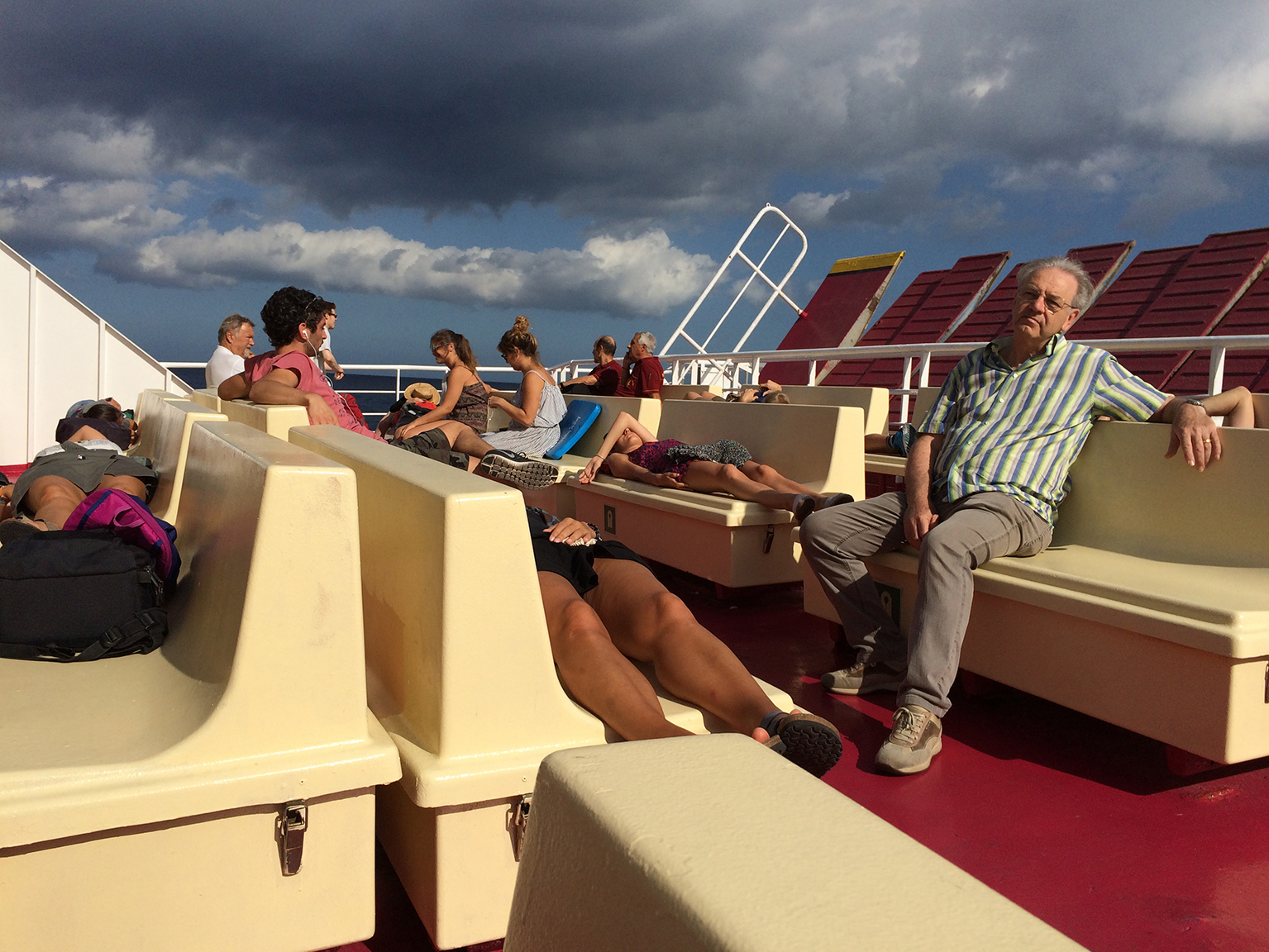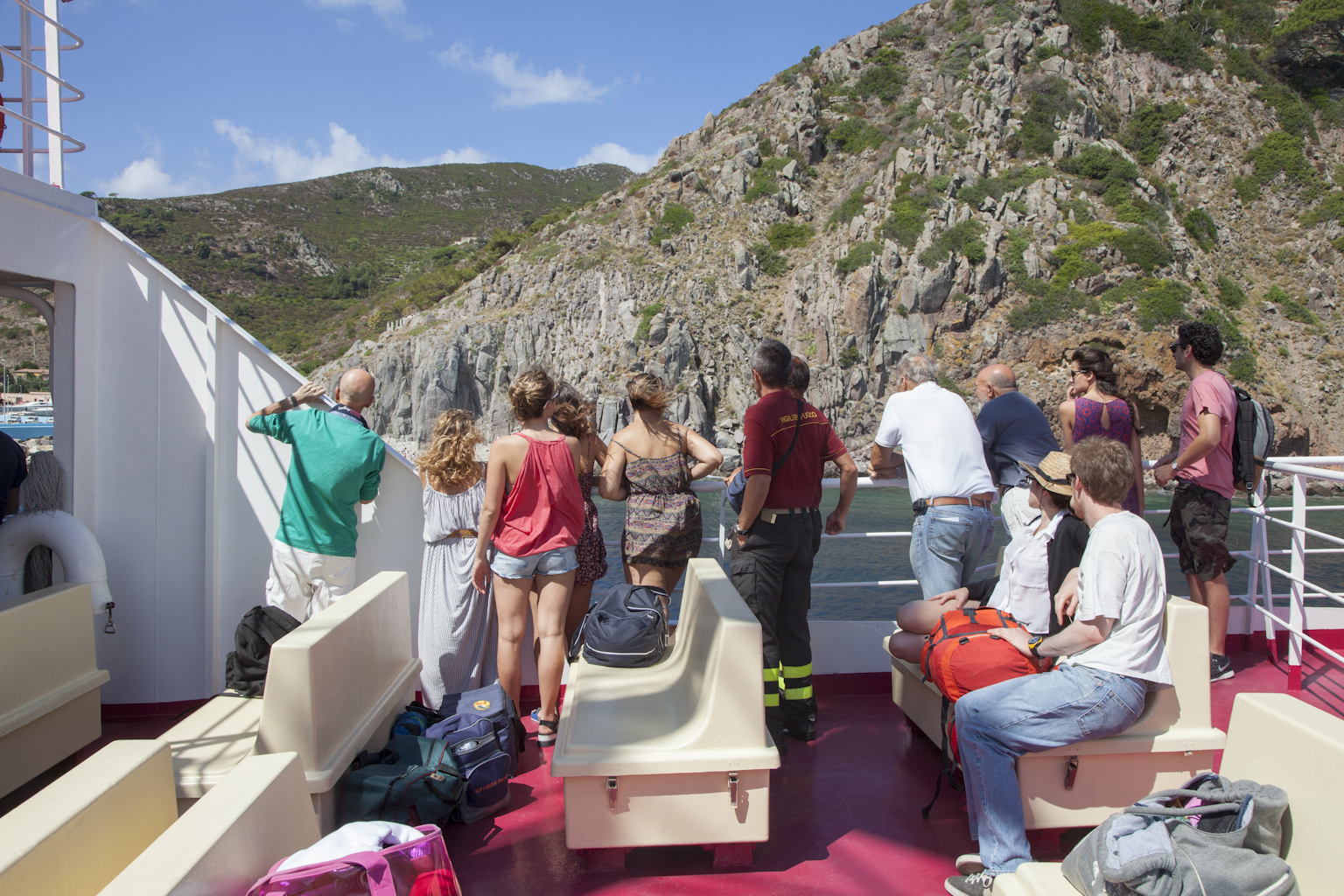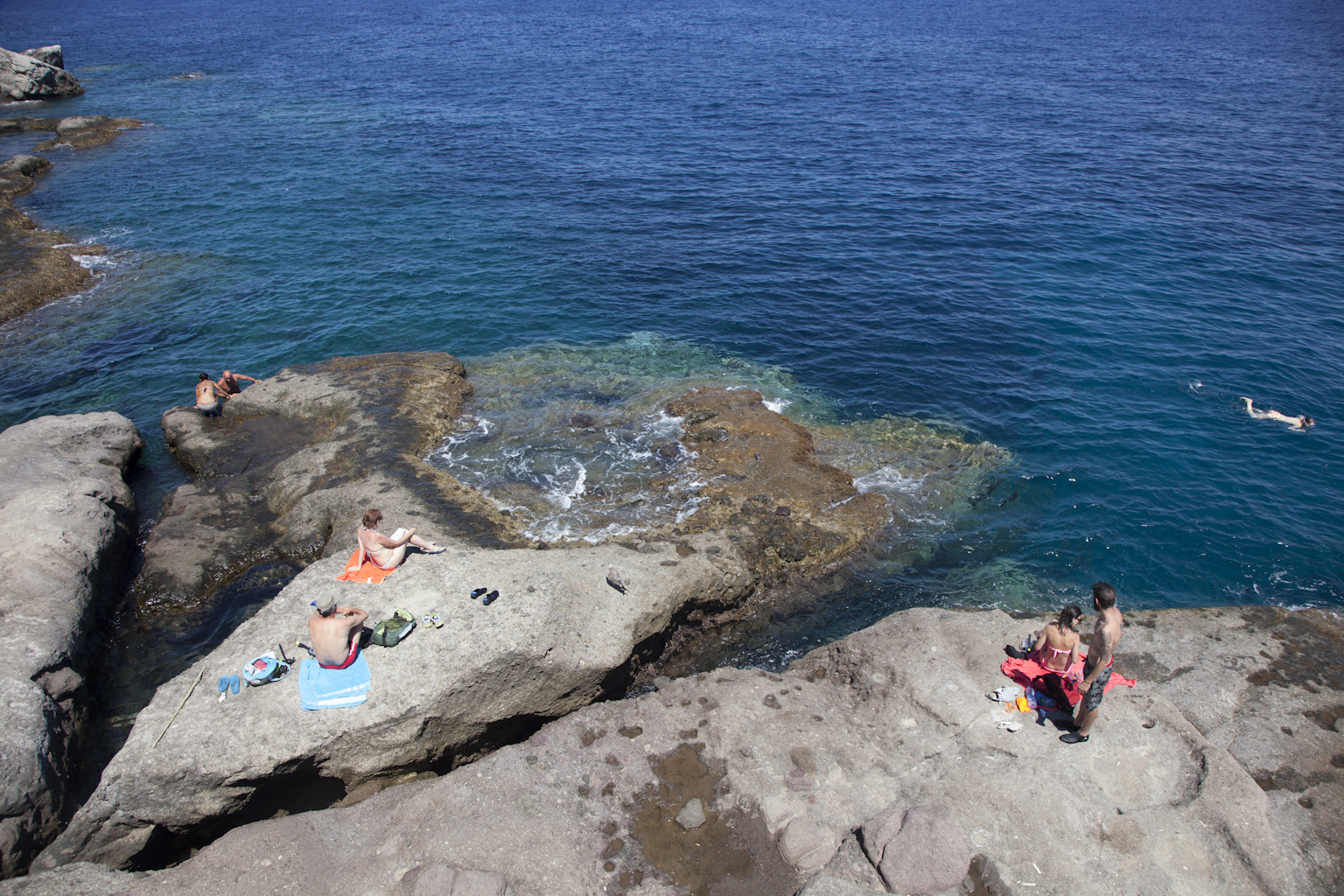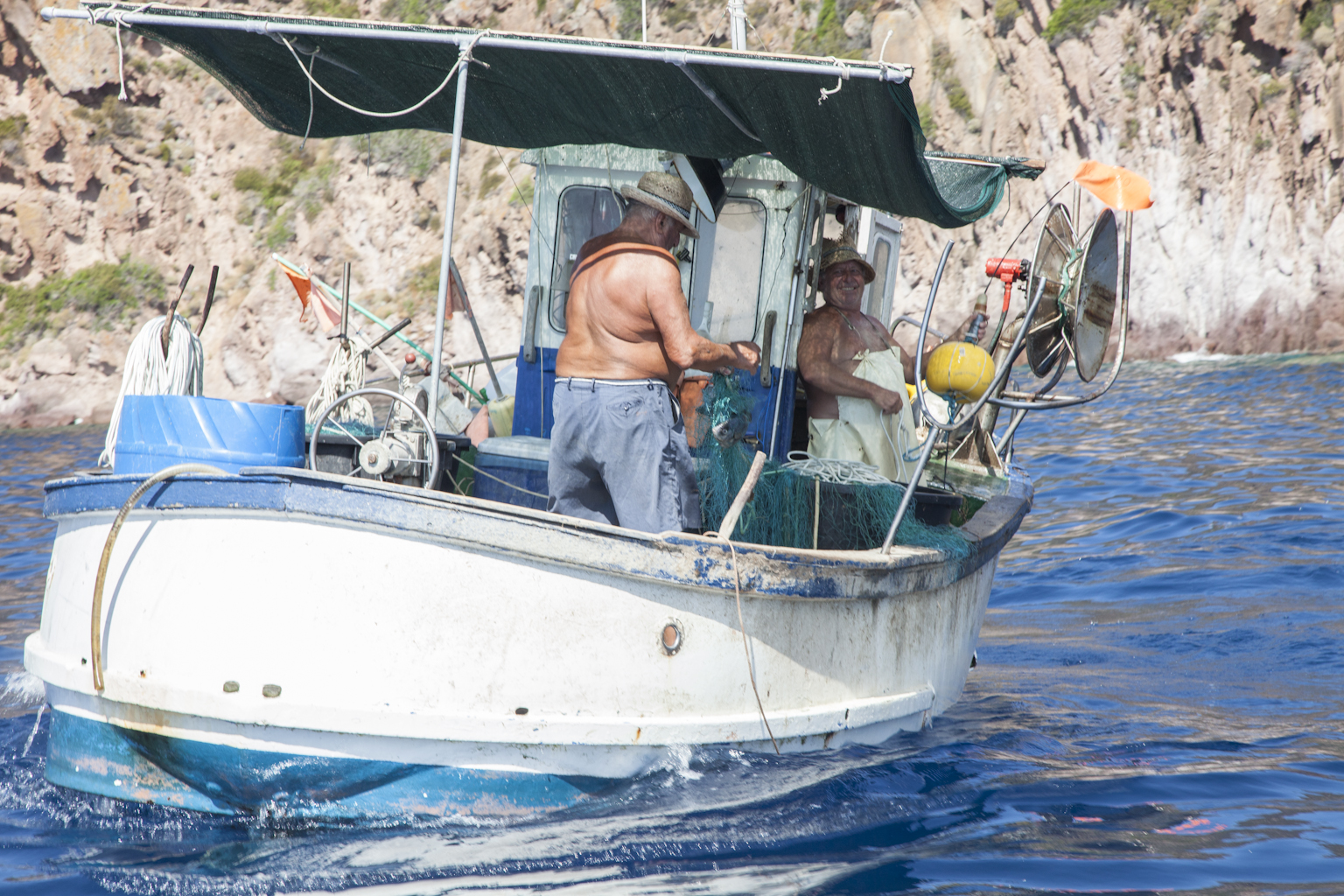il mare pone a confronto con l’ ambiguità, invita a sfidarla – sul mare immortale, scrive Conrad, si conquista il perdono delle proprie anime peccatrici. Al mare ci si spoglia, ci si toglie le soffocanti difese e ci si apre a ciò che sta davanti.
Claudio Magris, L’infinito viaggiare.
The second stop on our trip across the islands of the Tuscan archipelago was Capraia, third in size after Elba and Giglio. We embarked on this trip as a disrupted continuity of the previous one, thinking: not one island, two. But Capraia turned out to be the other face of the insular coin, the darker yet dazzled side of the concept of island: when it is closer to the place of imprisonment and repetition, when the map does not lead to a treasure but to the most beautiful trap.

Capraia is beautiful. We have been to few places of equal beauty. It is an open volcano that, when seen from a wide angle, reveals different strata: where the lava boiled, where it opened up in mountains, where the fire cooled. It depicts the hardened heart of a dead crater, a lunatic landscape with the gravity of fluctuating waves. This island is like Zbigniew Herbert’s dice: when one opens it, it only allows its surface to be seen, another layer, another silence, and the sea that polishes the facade and gives it a voice. Because Capraia is a great wall that hides the fact of its burned interior. It is an inside-out glove, an ex-prison whose ruins can be visited and whose inhabitants feel like children of the children of the children of the prisoners. It is an island of closed language and pronunciation, complicated, unique, and recurrent in its inner fire.
It was difficult to be Nobody there and to get lost amongst the people, like we did in Elba. Because in Capraia we were Somebody and deeply Other, another, altre, diverse. There, the truth of being foreign was multiplied to an unimaginable level, with all powers elevated to infinite numbers. We were the ones who did not know the codes, who did not speak the harsh, proper and charred language of the volcano, those who dared to walk without kissing the feet of the unknown goblin, those who did not jump three meters forward from gli scogli to verify that the edge of that shoreless sea is very deep. All this was hidden by the island and its people: a tradition.
But let’s start from the beginning.

1. The journey
Let’s press rewind with determination, so as not to arrive without having set sail or finishing without having started. Let’s talk about the journey, which was eloquent, great, the adventure we all want to tell someday but not to experience. Arriving in Capraia involved a tough, intense journey of hours.
We departed from Santa Maria Novella station in Florence on a 5 AM train that would take us to Livorno, one of the cities where Giorgio de Chirico would probably had been more comfortable, with its large stone spaces and monuments that do not rise completely because of the horizontality of the square, spaces filled with historical nothingness where people walk without questioning the culture—at least that is what we decided to assume—. Those people walk past a pier from where one cannot even distinguish the small island of our destination.

We arrived at the pier and boarded a tragheto, this time of the Toremar line. We missed Tosca and the whale, who had been our companions on a beautiful and peaceful journey to Elba. Neither was here now, but an entire team of vigili del fuoco—who we commonly call “firemen”—joined us. We quickly thought: either they put out a fire in Livorno and now they are returning to Capraia, or there is a fire in Capraia and they will return to Livorno. But it was neither: they were there—as we learned within five minutes of sailing—because «le condizione del mare e tempo sono avverse, just as we heard through the loudspeakers of the ship when left and right, port and starboard were already getting mixed up with the oscillating movement and the cars parked below were making noises like bumper cars. There was no panini nor wine nor beer, there was no form, just a great dizziness driving-cradling the place that carried us. «Move your head, let yourself go,» we thought, following some master sailor. «Merda!» The boys who had been playing up and down the ferry were now lying with their faces to the sky and with bags in their hands, very green and out, out, all out. The woman with the dog who had come aboard euphorically now did not move, each hand held by a fireman, one on each side, with paper bags, preparing the space for the hurl. We were trying to remain calm, trying to take photographs. «Loro stanno bene,» they said as they looked at us. «Bene?» we thought, «Is that a euphemism to say that we look pale but we are not giving up?»

Panic: the sea, with all its power, creates panic. Not to even think about the sailing days of real captains. Curses piling up on our tongues: «When will this blender stop?» Any romanticism was swallowed up by the truth of the story. But we continued striking ourselves with the camera and the cell phone, not resisting movement, hoping that the sea would not stick to some ruthless script. «How to endure?»
We think of a Spanish friend, Manuel, who spent more than two months on a ship stranded on the high seas during a mission. «Manuel, embody us,» we begged without speaking. «Manuel, what a brave fellow, he came back tanned, handsome, strong. Tosca, who lived at sea. Mari, at only 14, has always vacationed on sailboats. Richi, who usually goes sailing with friends. Andrea, who leaves for three months every year with a sailing crew. Gianna, who spent more than seven years at sea. So many! Destiny can’t just come pouncing on these two, who need only but three hours to reach the island.”

Suffering is like that, comparative, wickedly comparative. We thought of Lea, a young woman who traversed the planet by sea during a year. What didn’t we think about? These were the three longest hours of our lives. So many people circled the corridor of the choppy sea, so many vital young men were crushed onto the benches, desiring couples stopped kissing, the intrepid mother endured her children’s vomits and a friendly man handed out pills to his defeated family. People as green as Hulk: great as la-mole. «Tutto a posto?«—we asked the firemen—and, of course, the customary answer: «Sì, bene, il mare è così.»
And so it is, and so we arrived, a bit shaken, to Capraia.

2. The monolocale
We must bring up two details that we discovered: Italians—a good part of them, at least—live to think about what they are going to taste next: at breakfast they think about lunch and at lunch about the evening snack, they think about dinner later and, sometime in the afternoon, they order or buy what they will eat the next day. And what they will drink, of course. It is a ritual, and a well carried one.
The second detail we discovered is that they plan their summers with anticipation, and by April or May everyone must know where they will flee from the summer heat of the cities—ideally to the coast, ideally within Italy—. Eased up and beyond the reach of exchange control, we decided last-minute to rent what was left in Capraia: a monolocale, which we could define as “the place where you never want to be during the summer.” It was small, an actual commercial space, that’s true: a room with single beds, no bathroom door, no shower curtain, and a terrifying butane gas pump under a precarious kitchen. It was kind of weird, like a storage room transformed into an apartment. After the seasickness on the ship, the monolocale was a nightmare on land, so we hurriedly released our moorings and went in search of the beach.
Beach?
3. Spiaggia vs. Scoglio

From Wikipedia: «Uno scoglio è una porzione di roccia che emerge dalle acque del mare, normalmente nelle vicinanze di una costa rocciosa alta detta falesia.» That is: an area of stony cliffs, beautiful and complicated coves to access the sea, without surrounding sand. Going into those coves is a passionate work for the chosen few: the transcendental sensation that the sea will have mercy on us and return us to the rocks in the best possible way, with some marks on the skin and the soul, «open to all we have before us,” as Magris would say.
And so the days passed, and we found ourselves first descending and then climbing the steep terrain, with people scattered on the flat faces of the rocks, all facing the front, insisting on their need to feel part of that immortal being that is the sea.
4. The sea and the fire

We sailed the sea surrounding the island, trying to seize it, and somehow we got there, at last, on a boat, surrounded by strangers, trampled and shaken, as we gazed at the volcanic island and understood its outline, its forms, its vegetation; meanwhile, everyone around us acted like children before the waves, excited and full. But above all, we understood something that was not obvious: the heart of the island had never cooled, water was the lava of this open and stirred volcano—its own denial, sunken crater, fire-like water, all the symbols summoned together—. Nothing was gratuitous, the language was fire and everything burned on that island: its history, its present, the sea, the prison, the tales, the walks, the paths.

For four days we walked from the village to the pier, from the village to the coves, from the village to the old prison, from the village to the restaurants. We met a man who bought us fish and explained something very simple: «How not to build a jail on this island? Where could the inmates possibly escape to?» The four walls of the island are the sea, and that changes the perception of everything. We also understood that the island dwellers are trapped by the beauty that surrounds them.

The pier, the only beach with easy access and a conventional shore, sets a visual trap: on one side, a sky-blue wall separates it from the large circular plaza where the boats are anchored. Aside from the sea, this wall is the only possible horizon in Capraia: a drawing, a trace, and whoever climbs it can become the horizon, the prominence that competes with the sealine.
It is said that this island owes its name to the wild goats that inhabit it, and it surely must be true: Capraia is a fire animal that scurries between the rocks, with its head and chest to the air in the middle of the sea.

















